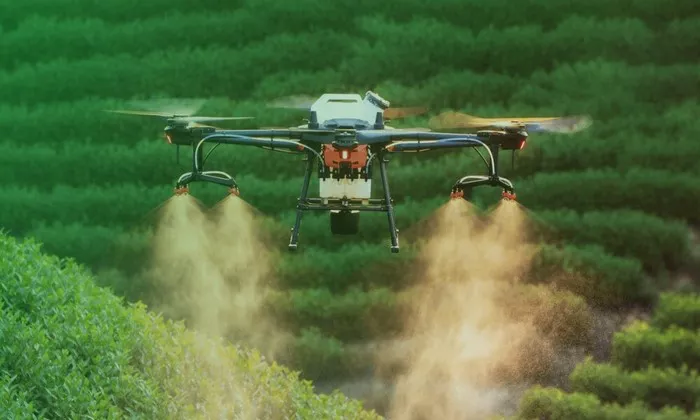Every growing season, thousands of pilots across the U.S. risk their lives flying small planes loaded with heavy pesticides, often at speeds exceeding 140 miles per hour and mere feet above crops like corn, cotton, and soybeans. This high-risk agricultural aviation sector is essential to American farming but remains perilous, with fatal crashes unfortunately common.
Enter Guardian Ag, a startup founded by former MIT Electronics Research Society (MITERS) makers Adam Bercu and Charles Guan ’11, offering a safer and more efficient alternative: a large, custom-built drone capable of autonomously delivering 200-pound pesticide payloads over farms. Featuring an 18-foot spray radius, 80-inch rotors, specialized battery packs, and aerospace-grade materials, these drones aim to transform crop spraying for large-scale American farms.
“We’re not just replacing a hand pump; we’re replacing tractors, helicopters, or airplanes,” explains Bercu. “An operator arrives about 30 minutes before spraying, mixes the product, plans the flight path in our app, and gets an estimate of the job duration. Our fast-charging batteries recharge while the tank is refilled—both processes take roughly the same time.”
From Robotics to Farmland Innovation
Bercu’s passion for robotics began in his youth in South Florida, where he built prototypes and competed in robotics contests, eventually meeting Guan—a mechanical engineering major at MIT—who convinced him to move to Cambridge to join the vibrant maker community. Together, they frequented MIT’s makerspaces, including MITERS and the Artisans Asylum.
After graduation, they launched a hardware consulting firm and competed on the robot combat show Battlebots. Guan also taught mechanical design at MIT, guiding students in building go-karts. Their combined experience sparked the idea to develop drones for crop spraying.
“Electric vehicle technology was advancing rapidly,” Bercu says. “While diesel remains better for long distances, batteries excel in short, high-power missions—perfect for tasks like crop spraying.”
With firsthand knowledge of the dangers agricultural pilots face—flying just six feet above ground at 140 mph carrying hundreds of gallons of pesticides—they set out to build a safer alternative. After piecing together parts from their Battlebots days, they created a 600-pound drone and launched Guardian Ag, supported early on by the MIT-affiliated E14 Fund.
Pioneering Regulatory Pathways
Navigating the Federal Aviation Administration (FAA) approval process was uncharted territory. “There was no category for drones like ours,” Bercu notes. “We didn’t just get approved; we helped build the regulatory framework, establishing common-sense standards along the way.”
Guardian Ag custom-designed its batteries to maximize drone efficiency. Their machines can spray 1.5 to 2 tons of payload per hour, delivering more precision than planes and minimizing pesticide runoff that harms the environment.
“The drone can spray the ‘Mona Lisa’ across 20 acres,” Bercu says, “but for now, we’re focusing on simplicity—teaching tractor sprayers to use drones in under a week.”
Scaling Up for Modern Farming
Guardian Ag has built eight drones, currently trialing them on farms in California. Production is ramping up at their 60,000-square-foot Massachusetts facility, backed by hundreds of millions in pre-orders.
“Farmers immediately see the value,” Bercu says. “They don’t need convincing. The big drone with the big tank sells itself.”
Beyond agriculture, Guardian sees potential in logistics for offshore rigs, mining, and other industries requiring transport over difficult terrain—currently relying on helicopters and small planes. For now, agriculture remains the company’s core focus.
“There’s a clear shortage of agricultural pilots,” says COO Ashley Ferguson MBA ’19. “Aerial spraying is vital, and multigenerational farms are eager for solutions.”
Reflecting on his journey, Bercu credits MIT’s welcoming community for his success. “I never went to college but hope to apply to MIT someday. The support I received here means everything. This company wouldn’t exist without MIT.”
Related topics:

